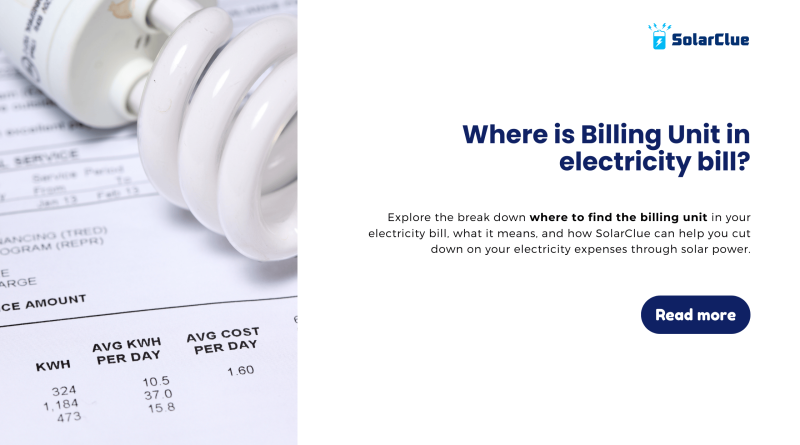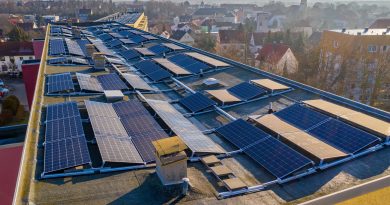Where is Billing Unit in electricity bill?
Understanding your electricity bill is crucial for managing your energy consumption and finding ways to save. One of the most important aspects of your bill is the billing unit, which represents the total amount of energy you’ve used during a billing period. But where exactly is this billing unit displayed, and how can you use this information to reduce your electricity costs?
In this blog, we’ll break down where to find the billing unit in your electricity bill, what it means, and how SolarClue can help you cut down on your electricity expenses through solar power.
Table of Contents
- 1 What is the Billing Unit on an Electricity Bill?
- 1.1 Where to Find the Billing Unit in Your Electricity Bill
- 1.2 Example: Understanding the Billing Unit on a Typical Electricity Bill
- 1.3 How to Reduce Your Billing Unit (kWh) and Save on Electricity Bills
- 1.4 Solar Power: The Best Way to Cut Your Energy Consumption and Costs
- 1.5 Comparison: Grid Electricity vs. Solar Power
- 1.6 Why Choose SolarClue for Your Solar Power Solution?
- 1.7 Call to Action: Switch to Solar with SolarClue and Save on Electricity Bills
What is the Billing Unit on an Electricity Bill?
The billing unit in an electricity bill refers to the amount of electricity you’ve consumed over a specific billing period, usually measured in kilowatt-hours (kWh). This is the standard unit for measuring electrical energy, and it indicates how much power your household or business has used.
A kilowatt-hour (kWh) is the amount of energy used when a 1-kilowatt appliance runs for 1 hour. For instance, if you use a 100-watt light bulb for 10 hours, you’ll consume 1 kWh of electricity.
Where to Find the Billing Unit in Your Electricity Bill
The billing unit is typically located in the section of your bill labeled “Consumption” or “Energy Usage.” This section shows how many kilowatt-hours (kWh) you’ve used during the billing cycle.
Here’s how to locate it on your electricity bill:
1. Look for the “Units Consumed” or “Meter Reading” Section
In most electricity bills, the billing unit is displayed under sections like “Units Consumed,” “Consumption,” or “Energy Usage.” It usually lists:
- Previous Meter Reading: The reading from your last bill.
- Current Meter Reading: The reading at the end of the current billing cycle.
- Units Consumed: The difference between the previous and current readings, showing how many kWh you’ve used.
2. Billing Period
Check the billing period to understand how long the consumption has been recorded for. The billing unit will reflect the total electricity used during this period (usually one month or two).
3. Tariff Rates
Next to the consumption details, you’ll typically see a breakdown of the tariff rates, which tells you how much you’re charged per kWh. This section shows how much you pay for each unit of electricity consumed.
Example: Understanding the Billing Unit on a Typical Electricity Bill
Let’s look at a sample breakdown of an electricity bill to understand where the billing unit fits in:
| Details | Amount |
|---|---|
| Previous Meter Reading | 4500 kWh |
| Current Meter Reading | 4700 kWh |
| Units Consumed (Billing Unit) | 200 kWh |
| Rate per Unit | ₹5 |
| Total Energy Charge (200 kWh) | ₹1000 |
| Fixed Charges | ₹100 |
| Total Bill | ₹1100 |
In this example, the billing unit is 200 kWh, which is the amount of energy consumed during the billing period. The total energy charge is calculated by multiplying the units consumed (200 kWh) by the rate per unit (₹5), resulting in ₹1000. Additional fixed charges bring the total bill to ₹1100.
How to Reduce Your Billing Unit (kWh) and Save on Electricity Bills
Reducing the number of kWh you use is key to lowering your electricity bill. Here are some strategies to help you reduce your consumption:
1. Energy-Efficient Appliances
Switch to energy-efficient appliances like LED bulbs, inverter ACs, and Energy Star-rated devices. These consume significantly less electricity compared to traditional models.
2. Unplug Devices Not in Use
Many devices continue to draw power even when turned off. Unplug appliances like chargers, TVs, and kitchen gadgets when not in use to prevent “phantom” energy consumption.
3. Use Smart Power Strips
Smart power strips can help you manage the power usage of multiple devices. These strips automatically cut off power to devices that aren’t being used, saving you money.
4. Optimize Air Conditioner Usage
Air conditioners are among the biggest energy consumers in households. Set your AC to 24-26°C and use ceiling fans to circulate cool air more efficiently, reducing the energy needed to cool your home.
5. Switch to Solar Power
By far, the most effective way to reduce your electricity bill in the long run is by switching to solar power. Solar power systems generate electricity using sunlight, drastically reducing the amount of energy you need to purchase from the grid.
Solar Power: The Best Way to Cut Your Energy Consumption and Costs
Switching to solar power allows you to generate your own electricity from a renewable source, significantly reducing your dependence on the grid. Here’s why it’s the ultimate solution for cutting down your billing unit and saving money:
1. Significant Reduction in kWh Usage
By generating your own solar energy, the kWh you consume from the grid drops significantly. This means your billing unit will show lower energy consumption, and your bill will be much lower as a result.
2. Long-Term Savings
Solar power systems require an upfront investment but offer long-term savings. Most solar systems pay for themselves within 4-7 years, after which the electricity generated is essentially free for the system’s 25+ year lifespan.
3. Net Metering: Sell Excess Power to the Grid
With net metering, you can sell any excess electricity generated by your solar system back to the grid. This results in credits on your electricity bill, further reducing your monthly expenses.
Comparison: Grid Electricity vs. Solar Power
| Factors | Traditional Grid Electricity | Solar Power |
|---|---|---|
| Monthly Billing Unit (kWh) | High, depending on usage | Low or zero, after solar setup |
| Energy Source | Non-renewable (coal, gas, etc.) | Renewable (sunlight) |
| Cost of Electricity | Dependent on utility tariffs | Free after installation |
| Return on Investment | No direct return | Payback in 4-7 years |
| Environmental Impact | High carbon footprint | Zero emissions |
| Protection from Rate Hikes | Vulnerable to rising electricity prices | Insulated from tariff increases |
Why Choose SolarClue for Your Solar Power Solution?
SolarClue is one of India’s leading solar power providers, offering top-quality solar energy solutions designed to help you reduce your electricity consumption and costs. Here’s why SolarClue is the best choice for solar power:
1. Trusted Solar Brands
SolarClue partners with industry-leading brands like Tata Power Solar, Luminous, Havells, and Sukam, ensuring the highest quality, efficiency, and reliability. With these trusted names, you can expect superior performance and durability from your solar power system.
2. Personalized Solar Solutions
Every home and business has unique energy needs, and SolarClue understands that. Their team of experts provides personalized consultations to help you choose the right solar system based on your energy usage, budget, and location.
3. Full-Service Installation and Support
From consultation to installation and post-installation support, SolarClue provides end-to-end service, ensuring a seamless transition to solar power. They also assist with government incentives, subsidies, and financing options to make solar power more affordable.
Call to Action: Switch to Solar with SolarClue and Save on Electricity Bills
If you’re looking for a sustainable and effective way to reduce your electricity bill and lower your billing unit, SolarClue has the perfect solution for you. With trusted solar brands, personalized guidance, and comprehensive service, SolarClue ensures that you get the most out of your solar investment.
Contact SolarClue today for a free consultation and start saving on your electricity bills by switching to solar power. Take control of your energy costs and contribute to a cleaner, greener future!
FAQs
1. How can I reduce the billing unit on my electricity bill?
You can reduce your billing unit (kWh) by using energy-efficient appliances, managing your electricity usage, and switching to solar power to generate your own energy.
2. How does switching to solar power reduce my electricity bill?
By generating your own electricity with a solar power system, you reduce the amount of energy you need to buy from the grid, thus lowering your electricity consumption and bill.
3. Does SolarClue offer financing options for solar power systems?
Yes, SolarClue offers flexible financing options and helps customers take advantage of government incentives and subsidies to make solar installations more affordable.
4. How long does it take for a solar power system to pay for itself?
Most solar power systems have a payback period of 4-7 years, after which you enjoy free electricity for the remaining life of the system, which can last 25 years or more.
5. Can I sell excess electricity back to the grid?
Yes, with net metering, you can sell any excess electricity generated by your solar system back to the grid and receive credits on your electricity bill.


